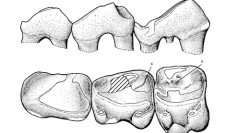

 Geodiversitas
22 (3) - Pages 395-414
Geodiversitas
22 (3) - Pages 395-414Reigitherium bunodontum (Mammalia, Docodonta, Reigitheriidae), from the Late Cretaceous (Campanian-Maastrichtian) La Colonia Formation (Patagonia, Argentina), is the first known docodont mammal from the southern hemisphere. Even though its lower dentition resembles more closely the North American Late Jurassic Docodon than other Eurasian docodonts (e.g., intermolar basins formed by the adjacent halves of molars, and vertical crenulations [or ribs and furrows]), it radically differs from Laurasian docodonts in that the crowns of the lower cheekteeth are transversely enlarged: several lingual cingular cusps are incorporated to the masticatory surface. The evolution of the reigitheriid lower molar pattern from the morganucodontid one seems to have involved three main modifications, resulting in a step-like process: 1) expansion of the lingual cingulum; 2) elevation of the lingual cingular cusps, becoming interconnected to each other by a crest high as or higher than the labial one, and enlargement of the masticatory surface by the close connection of both lingual and buccal crests; 3) aggregation of labial pillar-shaped cusps. Reigitherium bunodontum adds support to the hypothesis that Gondwanan land mammals evolved as vicariants of the Laurasian ones, and that in mammals the universal trend to increase the masticatory surface of the cheekteeth was also accomplished without passing through the reversed triangle stage that led to the tribosphenic pattern.
Gondwana, Patagonia, Late Cretaceous, Mammalia, Docodonta, vicariance events